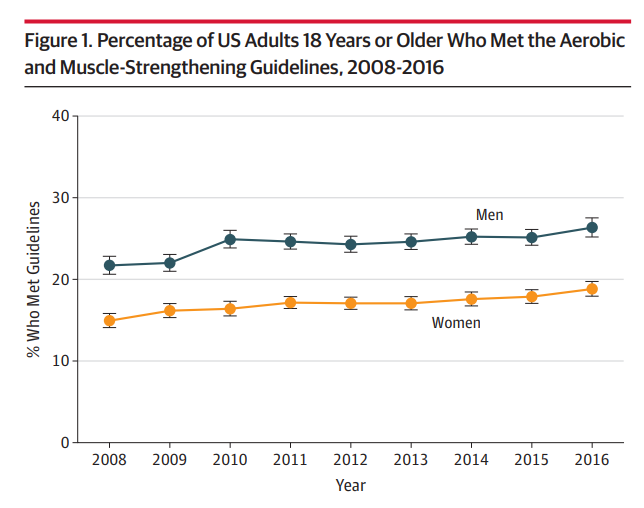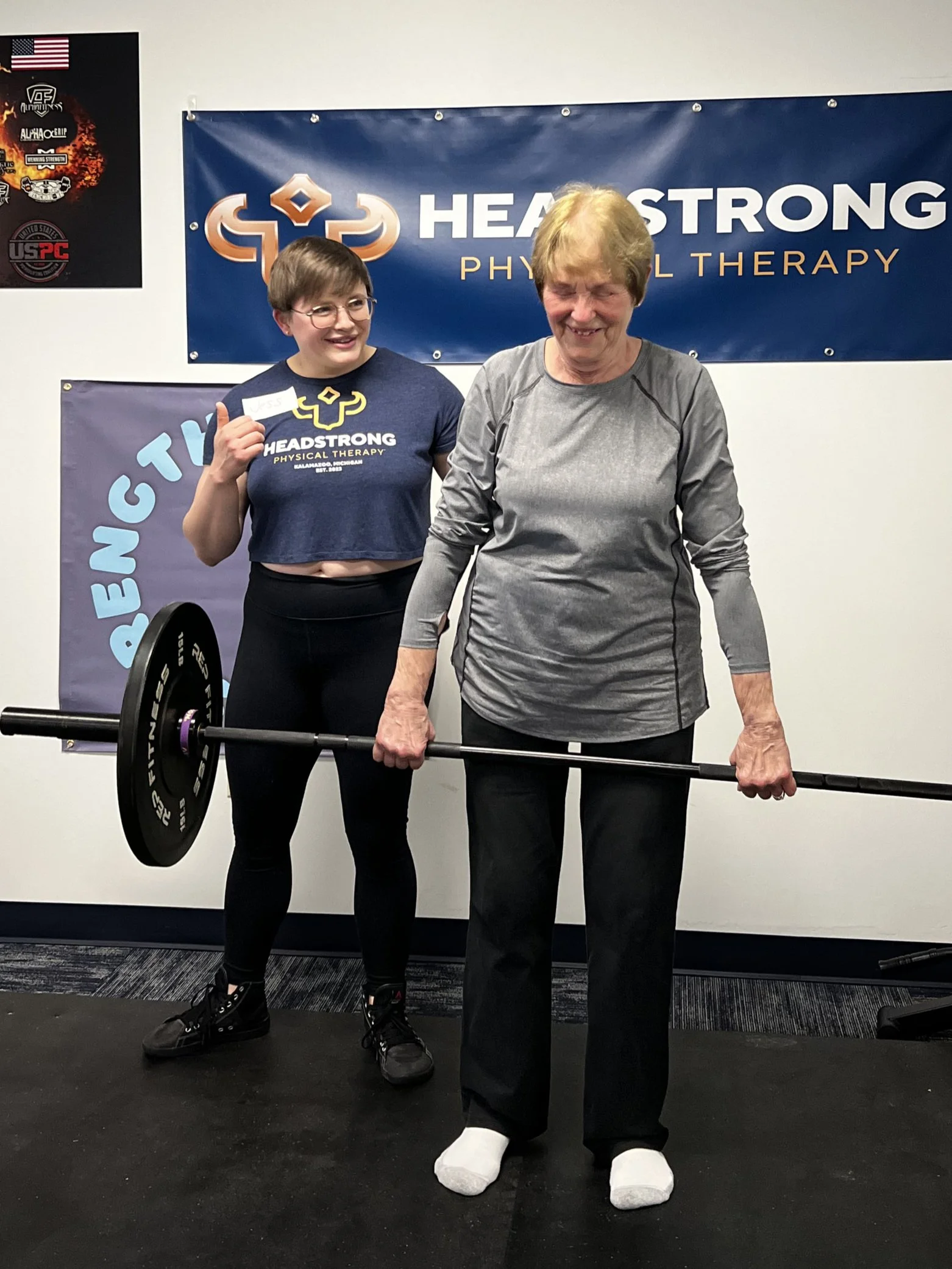Why You Should Be Strength Training
80% of adults do not get sufficient exercise[1].
When thinking about improving our health, many of us resolve to begin a new exercise program. Here at Headstrong, we firmly believe in the power of strength training for your health and longevity -- read below for our six top reasons why YOU should try lifting weights!
#1 We lose strength as we age!
In the absence of exercise, every decade after we reach 30 years of age, we lose 10% of our strength [2,3], along with a reduction in bone density [3] and overall power, one's ability to use their muscles rapidly (e.g to stand up from a seated position, or catch oneself after a loss of balance). As we get older, we may be at risk for sarcopenia, a progressive loss of strength and muscle affecting 10% or more of older adults [4]. Sarcopenia is associated with complications including longer recovery times and cognitive impairment [4]. An alarming fact? Leg strength is a top predictor for losing independence [5].
#2 Little time investment, big return, at any age!
Few forms of exercise offer so much benefit for so little time. Most guidelines recommend strength training twice per week, for at least 30 minutes[1]. For older adults in particular, the benefits can be profound:
In a study of older adults aged 90 and greater, high intensity strength training improved strength and walking speed [6].
Strength training as part of a regular exercise program can reduce risk for falls [7]!
#3 Manage pain
Strengthening your muscles can help manage your pain:
Exercise, including strength training, can help manage knee pain from osteoarthritis [8];
Any exercise, including strength training, is the most effective way to manage chronic low back pain [9]!
Wheelchair users are more likely to have shoulder pain [10], with up to 30-70% of users reporting shoulder pain! A shoulder strengthening program, including the STOMPS protocol, can help wheelchair users reduce pain and improve function [11].
#4 Cardioprotective Benefits
We don't often think of the benefits to our heart by strength training, but strength can help our heart health!
A massive study of over 28,000 women found that 82 minutes per week of strength training exercise can actually have a cardio-protective effect; women who regularly strength trained (regardless of their aerobic exercise habits) had a lower incidence of cardiovascular disease overtime [12]!
In a recent systematic review, researchers suggest 60 minutes per week of strength training reduced all-cause mortality by 27% [13].
#5 Variety is the spice of life!
There are many ways to get started, including:
Free weights (dumbbells, barbells) - an adjustable dumbbell set for home use can take you far!
Group classes at your local fitness center and/or Crossfit box
Weight machines at the gym - you don't have to use free weights!
Bodyweight exercises at the gym or at home - they're super effective! [14]
If you don't know where to start, a skilled physical therapist, chiropractor, or trainer can help get you started on a customized exercise program.
#6 It’s FUN!
When exploring different modes of exercise, the best program is the one you’ll do. Many people find strength training to be fun, and it’s a mode of exercise easy to perform in classes, in a group, or with an accountability buddy.
As a personal anecdote, lifting weights was one of the first ways Headstrong’s PT, Jess, discovered a love for exercise, eventually leading to a pursuit of powerlifting and competition (in the picture accompanying this text, Jess had just squatted 400-lb for the first time on the competitive platform!). She not only discovered her inner and outer strength, now she helps others do the same in her clinic and as a coach with Barbell Barkada.
References
Piercy KL, Troiano RP, Ballard RM, et al. The Physical Activity Guidelines for Americans. Jama. 2018;320(19):2020. doi:10.1001/jama.2018.14854
Clark, D.J., Pojednic, R.M., Reid, K.F., Patten, C., Pasha, E.P., Phillips, E.M., & Fielding, R.A. (2013). Longitudinal decline of neuromuscular activation and power in healthy older adults. The Journals of Gerontology, Series A: Biological Sciences & Medical Sciences, 68(11), 1419–1425. doi:10.1093/gerona/glt036
Guccione A, Wong R, Avers D. Geriatric Physical Therapy. 3rd ed. St. Louis: Elsevier; 2012
Yuan S, Larsson SC. Epidemiology of sarcopenia: Prevalence, risk factors, and consequences. Metabolism. 2023;144:155533. doi:10.1016/j.metabol.2023.155533
Judge JO, Schechtman K, Cress E, Group F. The Relationship Between Physical Performance Measures and Independence in Instrumental Activities of Daily Living. Journal of the American Geriatrics Society. 1996;44(11):1332-1341. doi:10.1111/j.1532-5415.1996.tb01404.x
Fiatarone MA. High-Intensity Strength Training in Nonagenarians. Jama. 1990;263(22):3029. doi:10.1001/jama.1990.03440220053029
Sherrington C, Whitney JC, Lord SR, Herbert RD, Cumming RG, Close JC. Effective exercise for the prevention of falls: a systematic review and meta‐analysis. Journal of the American Geriatrics Society 2008;56(12):2234‐43.
Fransen M, McConnell S, Harmer AR, Van der Esch M, Simic M, Bennell KL. Exercise for osteoarthritis of the knee. Cochrane Database of Systematic Reviews 2015, Issue 1. Art. No.: CD004376. DOI: 10.1002/14651858.CD004376.pub3.
Hayden JA, Ellis J, Ogilvie R, Malmivaara A, van Tulder MW. Exercise therapy for chronic low back pain. Cochrane Database Syst Rev. 2021;9(9):CD009790. Published 2021 Sep 28. doi:10.1002/14651858.CD009790.pub2
Liampas A, Neophytou P, Sokratous M, et al. Musculoskeletal Pain Due to Wheelchair Use: A Systematic Review and Meta-Analysis. Pain Ther. 2021;10(2):973-984. doi:10.1007/s40122-021-00294-5
Mulroy SJ, Thompson L, Kemp B, et al. Strengthening and optimal movements for painful shoulders (STOMPS) in chronic spinal cord injury: a randomized controlled trial. Phys Ther. 2011;91(3):305-324. doi:10.2522/ptj.20100182
BJ Kamada M, Shiroma EJ, Buring JE, Miyachi M, Lee IM. Strength Training and All-Cause, Cardiovascular Disease, and Cancer Mortality in Older Women: A Cohort Study. J Am Heart Assoc. 2017;6(11):e007677. Published 2017 Oct 31. doi:10.1161/JAHA.117.007677
Shailendra P, Baldock KL, Li LSK, Bennie JA, Boyle T. Resistance Training and Mortality Risk: A Systematic Review and Meta-Analysis. Am J Prev Med. 2022;63(2):277-285. doi:10.1016/j.amepre.2022.03.020
OO Tsuzuku S, Kajioka T, Sakakibara H, Shimaoka K. Slow movement resistance training using body weight improves muscle mass in the elderly: A randomized controlled trial. Scandinavian Journal of Medicine & Science in Sports. 2018;28(4):1339-1344. doi:10.1111/sms.13039




